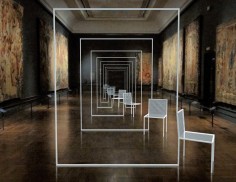STUDIO NENDO
Mimicry Chairs
source: londondesignfestival
It’s not everyday that a designer is given the opportunity to create a contemporary installation amid the splendour of the V&A Museum, which is already home to over four million items of historical and contemporary art and design. In 2012, the invitation was extended to Nendo, a Japanese studio that has emerged as one of the most dynamic design groups of the last decade.
“Now is the moment to commission Nendo,” declares Ben Evans, Director of London Design Festival. “The breadth and quality of their work is outstanding and they’re the new stars of design. It is why we have positioned them as a key project in our residency at the V&A this year.”
Nendo’s project was titled Mimicry Chairs and comprised a series of elegant chair installations appearing in varying locations throughout the Museum. Working in contrast to the often ornate museum surrounding, the studio created a simple chair archetype made from pressed and punched metal which was finished in white to give it an ethereal, almost ghost-like appearance.
A solo chair greeted visitors on arrival at the Grand Entrance. This singular statement was the basis for a series of installations located within the museum’s galleries, staircases and corridors. As you journed through the museum, the chairs were modified and morphed to mimic the particular space they inhabit as well as the surrounding objects.
Nendo is run by Oki Sato and Akihiro Ito who have completed scores of projects all over the world since their formation in 2002, ranging in scale from small handheld items, lighting and furniture to major exhibition and retail interiors. “I don’t know many designers who have produced such an astounding number of new works in such a short period. Oki has a curiosity that never stops. He is interested in everything, and always has something to say,” states Jana Scholze, Curator of Modern Furniture and Product Design at the V&A. “There is a playfulness in Nendo’s work, and a formal simplicity, which is deceptive because the birth of the products can be extremely complex.”


